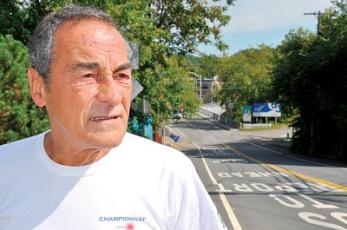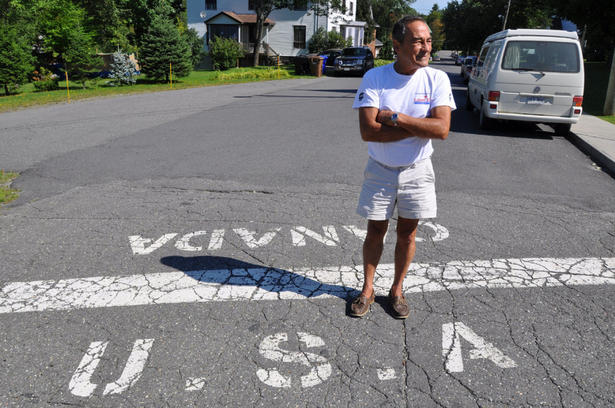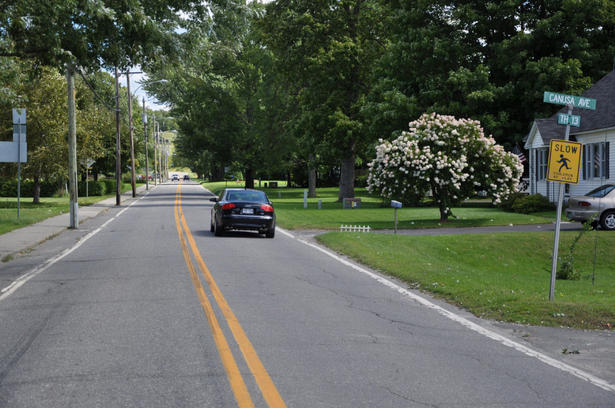
■Canusa Ave.一半位于美国,一半位于加拿大,中间用黄线标识。当地居民如果想过到另外一边,必须首先向边境站报告。罗伊的故事从买一张意大利薄饼起因,最后以入狱和罚款收场。星报Andrew Chung摄

Buzz Roy, a pharmacist from Derby Line, Vt., which abuts the border with Stanstead, Que., stands on the road where he was arrested by the U.S. Border Patrol after his own personal protest of border measures he says have torn the two communities apart. ANDREW CHUNG/TORONTO STAR

Canusa Ave. is half in Quebec, half in the United States. On this stretch the border is marked by the yellow line. Residents on each side must report to border stations nearby if they attempt to cross to the other side. ANDREW CHUNG/TORONTO STAR
星岛日报/罗伊(Buzz Roy)是居住在美加边境的药剂师。一天晚上,他想吃意大利薄饼(Pizza),于是打电话给位于魁省史丹士达镇(Stanstead)离边境数步之遥的Steve’s,订了个自取的大号烟肉薄饼。这一行为看似普通无奇,最后却以这位固执的69岁男子戴上手铐,投入常常关押非法移民和贩毒者的监狱收场。
当日罗伊拿到薄饼后,没有沿小镇的缅因街(Main St.)回家,因为缅因街上有一段陡坡,他选择较为平缓的教堂街(Church St.)。911袭击事件后,边境当局在贯穿两国边境的双线公路上设置闸门,两国居民使用教堂街时都需在闸门停留报关。不过,当地居民仍想当然地以为,他们还能像前几代人一样,自由从一边走到另一边,然后再上报海关。
罗伊拿到薄饼,在离其药店及住宅数步之遥的地方被警察截停。警员训诫他,不能从这里穿过,他必须走缅因街。罗伊回答,他本身是美国公民,只是回到自己的国家。不久,警员让他离开。不过,罗伊却不想就此罢手,身为村委员,他认为事情不应是这样。因此,他又下山进入加拿大,再度从教堂街穿回美国,也再度被截停。这一次,他与数名警员争论,但最终还是被放回家。回家后的罗伊怒气未减,故伎重演。这一次,边境巡逻队(Border Patrol)受够了,他们把罗伊扔进监狱,并罚款500元。他们警告说,罚金可高达5,000元。
罗伊坚称,重要的不是他做了什么,而是政府无情地收紧美加边境,而这条边境线过去对于两国小镇居民而言根本是无形的。罗伊的药店Brown’s Drug Store,距离缅因街美国海关的哨所只有几十米远,罗伊就住在药店上面。他说:“我在这个村庄长大,911之前,根本没有边界。我们是小孩子时,走路、骑车来回穿行。我们根本就没有想到那是另外一个小镇。现在,这边是美国,那边是加拿大。”
这一抱怨在史丹士达镇和德比线镇(Derby Line)居民中间非常普遍,两小镇以前是美加边境特殊关系的典范,现在却显现出2001年的恐怖袭击事件如何瓦解了这种关系。美国方面,出现更多边境巡逻队和海关官员,讯问和扣押变得更加频繁,执法人员到处都是。
911之后,没有人比史丹士达镇和德比线镇居民对这些变化的感受更加深切。因此,罗伊的境况触动了当地居民的心。在罗伊事件于2010年2月发生后不久,当地就组织了示威活动。
作为不恰当进入美国的行政制裁,罗伊别无选择,只能支付罚金。虽然他也聘请了佛蒙特州律师斯莱(David Sleigh)上诉,但两次上诉都无功而返。罗伊称,想在纽约的美国索偿法院(U. S. Court of Claims)控告政府,该法院通常处理国际贸易争端。
尽管记者一再要求美国海关及边境服务处就此事做出评论,但无人回应。加拿大边境服务处史丹士达镇的运营主管贝让(Miguel Begin)就承认,当地居民可能消极理解这些变动,但如果他们在防止走私、非法进入或犯罪行为方面做更多努力,情况就会变得积极。他还说,阻截贯穿边境的双线道路是与当地居民长期协商的结果。
资料来源:星报
Border towns struggle with post-9/11 security measures
Published On Fri Sep 02 2011
Andrew Chung
Quebec Bureau
DERBY LINE, VT.—Feeling like pizza for a late-evening dinner, Buzz Roy called up Steve’s, just a few steps across the border in Stanstead, Que., and ordered a large, smoked meat special for pick up.
A mundane act, on the surface. But this takeout order eventually led Roy, a 69-year-old pharmacist, to be turned around, placed in handcuffs and thrown in a cell that also sometimes holds illegal immigrants and drug smugglers.
Granted, Roy, a rather stubborn man with strong convictions, pushed his luck.
But what’s important, he insists, isn’t what he did. Rather, it’s what governments have done to inexorably thicken a Canada-U.S. borderline that in the past was all but invisible to residents of these two small towns.
“I was brought up in this village,” Roy says, sitting on the sun-drenched sidewalk outside his shop, Brown’s Drug Store, a couple dozen metres from the Main St. U.S. customs post here. “Until 9/11, it was a non-border. As kids we went back and forth walking, riding our bikes. We didn’t think of it as another town — ever.
“Now,” he says, gesturing with his hands, “this is the U.S.
“And that is Canada.”
It’s a common refrain among people in Stanstead and Derby Line, which has historically exemplified the special Canada-U.S. cross-border relationship — but now demonstrates how the 2001 terrorist attacks frayed it.
“Around the world borders are coming down,” says Kim Prangley, a dual citizen who lives on the Canadian side just down the hill from Roy’s store. “But here they’re making it harder than ever. The people are really demoralized.”
On the U.S. side, more border patrol and customs agents arrived — out-of-towners who depersonalized the small-town closeness between residents and authorities. Interrogations and detentions became more frequent. Law enforcement figures were everywhere.
Then they put up gates to block two side roads that cut through both towns. Residents on both sides managed to stop a gate from going up on Church St., which runs along the famed Haskell Free Library and Opera House, an edifice purposely built straddling the international boundary to symbolize the two countries’ friendship.
People assumed they could do what they’d been doing for generations — walk from one side to the other and then go report to customs.
Roy got his pizza, and instead of returning home via Main St., which has a steep incline, he took the more gradual Church. A police officer stopped him a stone’s throw from his store, above which he lives. “You can’t come through here,” the officer admonished. He had to take Main St.
“I’m a U.S. citizen. — I’m coming into my own country,” Roy replied.
After a while the officer let him go. But Roy was not content to let the issue slide. He was also a village trustee. Things were not supposed to be this way.
So he went back down the hill into Canada, simply to cross back into the U.S. again on Church St.
He was stopped again. This time he argued with several officers. And was allowed to check in and go home.
Still fuming, Roy did it again. This time, the Border Patrol had had enough. They threw him in the slammer and gave him a $500 fine. (It could have been $5,000, they warned.)
Nowhere have the changes implemented since 9/11 been more keenly felt than in Derby Line and Stanstead. Roy’s plight became a touchstone for people’s growing frustration. Not long after Roy’s February 2010 incident, a demonstration was organized.
After all, these two towns had always acted as one. Like the library, there are several buildings that are partly in both countries. Derby Line gets its water and sewage services from Canada. On one stretch of bungalow-dotted Canusa Ave., the yellow line down the middle marks the border.
Former U.S. customs officer and village trustee chairman Keith Beadle, 63, attended the rally to support Roy.
Disallowing someone from using Church St. to enter the U.S. was an “arbitrary change of something that’s been going on for 100 years,” Beadle says.
“People could see it was going to divide the community.”
As an administrative sanction for improperly entering the United States, Roy had no choice but to pay the fine. But he hired Vermont lawyer David Sleigh, and they have appealed it twice to no avail.
Sleigh and Roy recently gave notice they intend to sue the government at the U.S. Court of Claims in New York, which typically deals with international trade disputes.
For Roy it’s the principle of the thing.
A local magazine asked the question: is he a freedom fighter or rabble rouser?
“I’m a freedom fighter,” he says, smiling. “I despise control just for control sake. The Homeland Security budget is huge, and most of it is for garbage like this. Meanwhile, the 9/11 terrorists entered the country legally.”
No one from U.S. Customs and Border Protection responded to repeated requests for comment.
Miguel Begin, the chief of operations for the Canada Border Services Agency’s Stanstead sector, recognizes that residents might perceive changes to the border negatively. “But the more effort we make in trying to stop people from doing smuggling or illegal entries or criminal activities, it can only be positive,” he says.
The blocking of the side roads was the result of a long process of negotiation with residents, he adds, explaining that few locals recognize the problems created by the roads, and that’s why the fences were necessary.
Still, Beadle insists that “we’re losing a lot. We’re growing further apart from our neighbours.”
One measure of that can be found at the majestic stone and brick library and opera house at the top of Church St.
They call it the only library without books and the only theatre without a stage in the U.S. That’s because the border line runs right through the building, and both the books and the stage are in Canada.
The border tightening has led to less tourism, says the theatre’s manager, Lynn Leimer, particularly among Canadians. Many don’t know that though you’re allowed to walk on the sidewalk from Canada to the building entrance, which is on the U.S. side, you cannot drive to the parking lot, also on the U.S. side, without reporting to customs.
“It’s not as easy to come across, and it’s confusing for visitors,” Leimer says.
For a while, so many people were getting picked up and interrogated by the U.S. Border Patrol that Stanstead Mayor Philippe Dutil put up a temporary fence across the road. He says the border patrol has agreed to not automatically detain people, so the fence has been removed.
But Leimer recalls how a performer from Montreal arrived one day at the opera house, only to be taken away by agents. “He vowed never to come back,” she says.
Since 2009, the U.S. has also required travellers to have a passport to cross. Canadian customs agents in the area have acquired new technology and are now systematically entering all travellers’ information, like at airports.
New issues keep cropping up. Prangley, who ran the Haskell Free Library for 24 years, was furious last May when she tried to walk into the U.S. as a pedestrian — ironically to attend a “dance for universal peace” — and was told by the customs agent to “get in line and advance with the cars.”
She refused. “I could not believe what he told me,” she recalls. “That was the end of any sense of community here. The way we’re treated is really insulting lots of the time. The questions are degrading, they insinuate you have an ulterior motive even if you’re going to go get gas.
“But this is our community for God’s sake, founded on goodwill, intimately woven together.
“It’s just not fun anymore.”
http://www.thestar.com/news/article/1048571#


